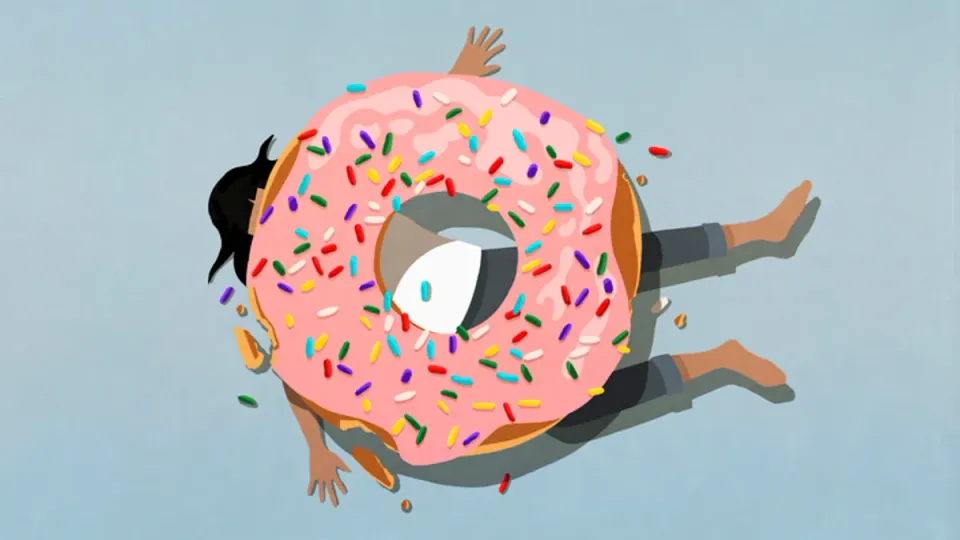Understanding Dopamine's Role in Food Addiction and Overeating

Dopamine, a word often tossed around in casual conversations about pleasure and reward, is far more complex and multifaceted than most realize.
It's not just a "feel-good" chemical; it's a neuromodulator that plays a crucial role in our actions, emotions, and even our social interactions. Let's dive into the world of dopamine and explore its various aspects, including its role in addiction and how food plays into all of this.
Dopamine: The Action Catalyst
Dopamine is the substrate from which adrenaline is made (or epinephrine in the brain), allowing us to spring into action. Think of it as the spark that ignites the engine of our motivation and drive.
The mesolimbic pathway, also known as the reward circuitry, consists of the ventral tegmental area (VTA) and nucleus accumbens. This circuitry tells us whether something in our environment feels good (driving us toward it) or bad (driving us away).
Ever noticed how the smell of Christmas or holiday meals is stimulating before you eat, but almost aversive when you're full? That's dopamine at work, highly plastic and contextually dependent, communicating with memory systems in the hippocampus.
Prefrontal Cortex and Dopamine

The prefrontal cortex plays a vital role in setting rules and understanding appropriate responses given context. If you get excited or anticipate something, the rate of dopamine firing can increase 30-40x, pushing you to action.
For example, sex doubles dopamine levels, nicotine and chocolate increase it by 150%, and cocaine and amphetamines can increase it by approximately 1000%. Even video games can release dopamine somewhere between nicotine and cocaine levels.
How Food Plays Into All This
The relationship between food and dopamine is a fascinating dance that intertwines our biological needs, social connections, and emotional well-being. Let's explore this intricate connection in more detail.
The Anticipation and Reward of Eating
Have you ever noticed how the mere thought of your favorite dish can make your mouth water?
That's dopamine at work, signaling the anticipation of a reward. The smell, sight, and even the thought of food can stimulate dopamine production, driving us toward the pleasure of eating.
When we finally take that first bite, dopamine levels surge, reinforcing the pleasure and satisfaction of eating. This reward system has evolved to ensure we seek out and consume the nutrients needed to survive.
Social Aspect of Food

Sharing a meal with friends and family isn't just about nourishment; it's a deeply social and bonding experience.
Food brings people together, and the act of sharing a meal can release dopamine, enhancing feelings of connection and joy.
In many cultures, food is at the heart of celebrations and gatherings, symbolizing love, friendship, and community.
The dopamine response to these social interactions around food strengthens our social bonds and adds a layer of pleasure to our communal dining experiences.
The Dark Side: Food Addiction and Overeating
Unfortunately, the dopamine response to food isn't always positive. For some, the pleasure of eating can become an addiction, leading to overeating and unhealthy dietary habits.
Highly palatable foods, especially those rich in sugar, fat, and salt, can trigger a significant dopamine response. This can lead to a cycle where the individual seeks out these foods to experience the pleasure again, often at the expense of their health.
Understanding the role of dopamine in food addiction can provide insights into treatment and support for those struggling with this issue. Strategies that focus on mindful eating, emotional awareness, and building healthy habits can help break the cycle of addiction and restore a balanced relationship with food.
Dopamine and Diet Choices
Dopamine also plays a role in our diet choices.
Foods that are rich in protein, such as meat and dairy products, contain the amino acid tyrosine, which is a precursor to dopamine. Consuming these foods can increase dopamine production, influencing our mood and energy levels.
Understanding this connection can help individuals make informed diet choices that align with their mental and physical well-being. For example, incorporating foods that support dopamine production can be part of a strategy to manage mood disorders or enhance overall emotional wellness.
A Balanced Approach
The relationship between food and dopamine is complex and multifaceted. While it brings joy and connection, it can also lead to challenges such as overeating and addiction.
As a dietitian and nutritional psychologist, I encourage you to reflect on your own relationship with food and dopamine.
Consider how your eating habits align with your emotional needs and social connections. Embrace the pleasure of eating, but also recognize the importance of balance and mindfulness in your dietary choices.
Here are five tangible ways to align your eating habits with your emotional needs and social connections, embracing the pleasure of eating while maintaining balance and mindfulness:
- Mindful Eating Practice:
Slow down and savor each bite. Pay attention to the flavors, textures, and aromas of your food. This practice can enhance your enjoyment of eating and help you tune into your body's hunger and fullness cues, promoting a balanced relationship with food. - Emotional Awareness:
Recognize the emotions that drive your eating habits. Are you eating out of hunger, or are you seeking comfort or distraction? Understanding the emotional triggers for eating can help you make more mindful choices and avoid overindulgence. - Social Dining:
Make an effort to share meals with friends and family. The social connection and enjoyment of communal dining can enhance the pleasure of eating and foster a positive relationship with food. Plus, it aligns with our innate need for social bonding. - Balanced Diet Choices:
Focus on a balanced diet that includes a variety of nutrient-dense foods. This not only supports physical health but also promotes emotional well-being. Including foods rich in dopamine precursors, such as lean proteins, can positively influence mood and energy levels. - Professional Guidance:
If you find yourself struggling with food-related addiction or unhealthy eating patterns, consider seeking professional guidance from a dietitian or psychologist. Personalized support can provide the tools and strategies needed to navigate the complex relationship between food, dopamine, and emotions.
By implementing these tangible strategies, you can cultivate a more mindful and balanced approach to eating. Embracing the pleasure of food while recognizing the importance of emotional and social connections can lead to a more fulfilling and nourishing relationship with what you eat.
It's not just about what's on your plate; it's about how you approach it, savor it, and integrate it into your overall well-being. Enjoy the journey to thriving with food! Remember, food is not just fuel; it's a source of joy, connection, and well-being.
Let's use our understanding of dopamine to thrive in our relationship with food and nourish not just our bodies but our souls as well.
Now, dear reader, reflect on your own journey with dopamine.
How does it influence your daily life?
What tangible ways can you apply this knowledge?
Perhaps it's time to savor that piece of chocolate with a newfound appreciation for the dopamine dance happening in your brain.
Enjoy, and thrive!